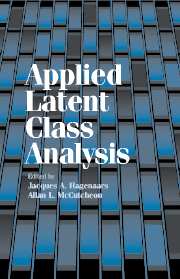Book contents
- Frontmatter
- Contents
- Contributors
- Preface
- INTRODUCTION
- CLASSIFICATION AND MEASUREMENT
- 3 Latent Class Cluster Analysis
- 4 Some Examples of Latent Budget Analysis and Its Extensions
- 5 Ordering the Classes
- 6 Comparison and Choice: Analyzing Discrete Preference Data by Latent Class Scaling Models
- 7 Three-Parameter Linear Logistic Latent Class Analysis
- CAUSAL ANALYSIS AND DYNAMIC MODELS
- UNOBSERVED HETEROGENEITY AND NONRESPONSE
- Appendix A: Notational Conventions
- Appendix B: Further Readings
- Appendix C: Selected Software; Webpage
- Index
3 - Latent Class Cluster Analysis
Published online by Cambridge University Press: 31 July 2009
- Frontmatter
- Contents
- Contributors
- Preface
- INTRODUCTION
- CLASSIFICATION AND MEASUREMENT
- 3 Latent Class Cluster Analysis
- 4 Some Examples of Latent Budget Analysis and Its Extensions
- 5 Ordering the Classes
- 6 Comparison and Choice: Analyzing Discrete Preference Data by Latent Class Scaling Models
- 7 Three-Parameter Linear Logistic Latent Class Analysis
- CAUSAL ANALYSIS AND DYNAMIC MODELS
- UNOBSERVED HETEROGENEITY AND NONRESPONSE
- Appendix A: Notational Conventions
- Appendix B: Further Readings
- Appendix C: Selected Software; Webpage
- Index
Summary
INTRODUCTION
Kaufman and Rousseeuw (1990) define cluster analysis as the classification of similar objects into groups, in which the number of groups as well as their forms are unknown. The form of a group refers to the parameters of cluster; that is, to its cluster-specific means, variances, and covariances that also have a geometrical interpretation. A similar definition is given by Everitt (1993), who speaks about deriving a useful division into a number of classes, in which both the number of classes and the properties of the classes are to be determined. These could also be definitions of exploratory latent class (LC) analysis, in which objects are assumed to belong to one of a set of K latent classes, with the number of classes and their sizes not known a priori. In addition, objects belonging to the same class are similar with respect to the observed variables in the sense that their observed scores are assumed to come from the same probability distributions, whose parameters are, however, unknown quantities to be estimated. Because of the similarity between cluster and exploratory LC analysis, it is not surprising that the latter method is becoming a more popular clustering tool.
In this paper, we describe the state-of-the-art in the field of LC cluster analysis. Most of the work in this field involves continuous indicators assuming (restricted) multivariate normal distributions within classes.
- Type
- Chapter
- Information
- Applied Latent Class Analysis , pp. 89 - 106Publisher: Cambridge University PressPrint publication year: 2002
- 820
- Cited by



